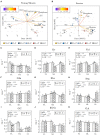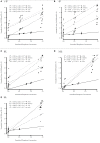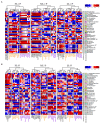Light Intensity Modulates the Effect of Phosphate Limitation on Carbohydrates, Amino Acids, and Catechins in Tea Plants (Camellia sinensis L.)
- PMID: 34691121
- PMCID: PMC8532574
- DOI: 10.3389/fpls.2021.743781
Light Intensity Modulates the Effect of Phosphate Limitation on Carbohydrates, Amino Acids, and Catechins in Tea Plants (Camellia sinensis L.)
Abstract
Metabolites are major contributors to the quality of tea that are regulated by various abiotic stresses. Light intensity and phosphorus (P) supply affect the metabolism of tea plants. However, how these two factors interact and mediate the metabolite levels in tea plants are not fully understood. The present study investigated the consequences of different light intensity and P regimes on the metabolism of carbohydrates, amino acids, and flavonoids in the Fengqing tea cultivar. The leaves and young shoots were subjected to untargeted metabolomics analysis by two-dimensional gas chromatography coupled to time-of-flight mass spectrometry (GC×GC-TOF/MS), ultra-performance liquid chromatography-quadrupole-TOF/MS (UPLC-Q-TOF/MS), and targeted analysis by high-performance liquid chromatography (HPLC) along with quantification of gene expression by quantitative real time-PCR (qRT-PCR). The results from young shoots showed that amino acids, pentose phosphate, and flavonol glycosides pathways were enhanced in response to decreasing light intensities and P deficiency. The expression of the genes hexokinase 1, ribose 5-phosphate isomerase A (RPIA), glutamate synthetase 1 (GS1), prolyl 4-hydroxylase (P4H), and arginase was induced by P limitation, thereafter affecting carbohydrates and amino acids metabolism, where shading modulated the responses of transcripts and corresponding metabolites caused by P deficiency. P deprivation repressed the expression of Pi transport, stress, sensing, and signaling (SPX2) and induced bidirectional sugar transporter (SWEET3) and amino acid permeases (AAP) which ultimately caused an increase in the amino acids: glutamate (Glu), proline (Pro), and arginine (Arg) under shading but decreased catechins [epicatechingallate (ECG) and Gallic acid, GA] content in young shoots.
Keywords: Camellia sinensis L; gene expression; interaction; light intensity; metabolic pathway; phosphorus.
Copyright © 2021 KC, Long, Liu, Zhang and Ruan.
Conflict of interest statement
The authors declare that the research was conducted in the absence of any commercial or financial relationships that could be construed as a potential conflict of interest.
Figures









Similar articles
-
Effect of Interactions between Phosphorus and Light Intensity on Metabolite Compositions in Tea Cultivar Longjing43.Int J Mol Sci. 2022 Dec 2;23(23):15194. doi: 10.3390/ijms232315194. Int J Mol Sci. 2022. PMID: 36499516 Free PMC article.
-
Metabolic Changes of Amino Acids and Flavonoids in Tea Plants in Response to Inorganic Phosphate Limitation.Int J Mol Sci. 2018 Nov 21;19(11):3683. doi: 10.3390/ijms19113683. Int J Mol Sci. 2018. PMID: 30469347 Free PMC article.
-
Metabolomic analysis using ultra-performance liquid chromatography-quadrupole-time of flight mass spectrometry (UPLC-Q-TOF MS) uncovers the effects of light intensity and temperature under shading treatments on the metabolites in tea.PLoS One. 2014 Nov 12;9(11):e112572. doi: 10.1371/journal.pone.0112572. eCollection 2014. PLoS One. 2014. PMID: 25390340 Free PMC article.
-
Metabolomics reveals the within-plant spatial effects of shading on tea plants.Tree Physiol. 2021 Feb 2;41(2):317-330. doi: 10.1093/treephys/tpaa127. Tree Physiol. 2021. PMID: 33104217
-
Exploring plant metabolic genomics: chemical diversity, metabolic complexity in the biosynthesis and transport of specialized metabolites with the tea plant as a model.Crit Rev Biotechnol. 2020 Aug;40(5):667-688. doi: 10.1080/07388551.2020.1752617. Epub 2020 Apr 22. Crit Rev Biotechnol. 2020. PMID: 32321331 Review.
Cited by
-
CsSPX3-CsPHL7-CsGS1/CsTS1 module mediated Pi-regulated negatively theanine biosynthesis in tea (Camellia sinensis).Hortic Res. 2024 Aug 30;11(11):uhae242. doi: 10.1093/hr/uhae242. eCollection 2024 Nov. Hortic Res. 2024. PMID: 39534409 Free PMC article.
-
Transcriptome and metabolome analysis reveals mechanism of light intensity modulating iridoid biosynthesis in Gentiana macrophylla Pall.BMC Plant Biol. 2024 Jun 11;24(1):526. doi: 10.1186/s12870-024-05217-y. BMC Plant Biol. 2024. PMID: 38858643 Free PMC article.
-
CsEXL3 regulate mechanical harvest-related droopy leaves under the transcriptional activation of CsBES1.2 in tea plant.Hortic Res. 2024 Mar 7;11(5):uhae074. doi: 10.1093/hr/uhae074. eCollection 2024 May. Hortic Res. 2024. PMID: 38738211 Free PMC article.
-
Effect of Interactions between Phosphorus and Light Intensity on Metabolite Compositions in Tea Cultivar Longjing43.Int J Mol Sci. 2022 Dec 2;23(23):15194. doi: 10.3390/ijms232315194. Int J Mol Sci. 2022. PMID: 36499516 Free PMC article.
-
Metabolic footprints in phosphate-starved plants.Physiol Mol Biol Plants. 2023 May;29(5):755-767. doi: 10.1007/s12298-023-01319-3. Epub 2023 Jun 14. Physiol Mol Biol Plants. 2023. PMID: 37363416 Free PMC article. Review.
References
-
- Ceasar S. A. (2020). Regulation of low phosphate stress in plants. Plant Life Under Changing Environ. 2020, 123–156. 10.1016/B978-0-12-818204-8.00007-2 - DOI
-
- del-Pozo J. C., Allona I., Rubio V., Leyva A., de-la-Pena A., Aragoncillo C., et al. . (1999). A type 5 acid phosphatase gene from Arabidopsis thaliana is induced by phosphate starvation and by some other types of phosphate mobilising/oxidative stress conditions. Plant J. 19, 579–589. 10.1046/j.1365-313X.1999.00562.x - DOI - PubMed
LinkOut - more resources
Full Text Sources
Research Materials
Miscellaneous

